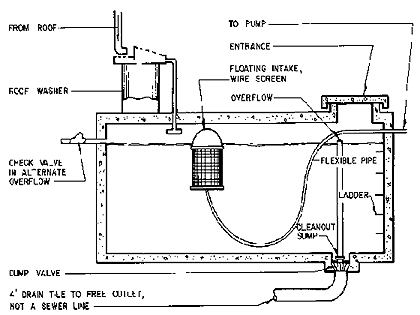      |
| |
|
|
|
|
|
| |
|
| |
|
| Components |
|
There are six basic components
to any type of cistern:
1. Catchment Area/Roof-surface that rain falls on
2. Gutters/Downspouts-moves water from roof to cistern
3. Leaf Screens/Roofwashers-prevents debris from entering the system
4. Storage Tanks (Cistern)-structure in which rainwater is stored
5. Conveying System-gravity or pumping system
6. Water Treatment-filters and equipment plus additives to settle,
filter and disinfect stored water |
|
| |
|

|
|
| Figure 1: Typical Underground
Cistern |
|
| |
|
| Cistern
Types |
|
MATERIALS
|
FEATURES |
CAUTION |
| Plastics |
Garbage cans(20-50
gal)
|
Commercially
available |
Use
only new cans |
| Fiberglass |
Commercially available,
Alterable and moveable |
Degradable, requires interior
coating |
| Polyethylene/Polypropylene
|
Commercially available,
Alterable and moveable |
Degradable, requires exterior
coating |
| Metals |
Steel drums
(55 gal)
|
Commercially
available,
Alterable and moveable |
Verify prior
use for toxins, corrodes and rusts, small capacity |
| Galvanized
Steel Tanks |
Commercially
available,
Alterable and moveable |
Possible corrosion
and rust |
| Concrete
and Masonry |
Ferrocement
|
Durable, immovable
|
Potential to
crack and fall |
| Stone, Concrete Block |
Durable, immovable |
Difficult to maintain |
| Monolithic/Poured in Place |
Durable, immovable |
Potential to crack |
| Wood |
| Redwood, Douglas Fir, Cypress
|
Attractive, durable |
Expensive
|
|
|
|
| |
|
|


